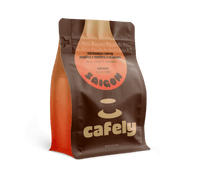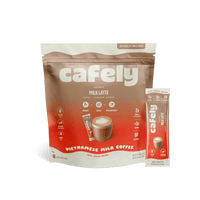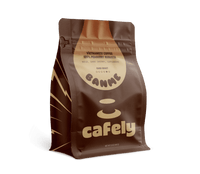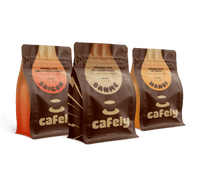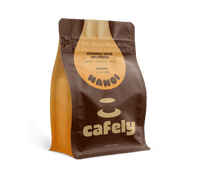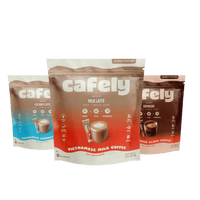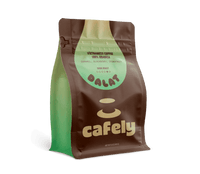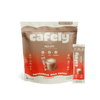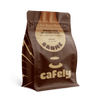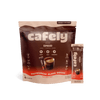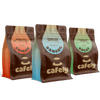Nearly every country – from the United States to Japan to the UK and back — enjoys the warm buzz of the coffee bean. With coffee's ubiquity, it's easy to take coffee for granted but it remains a major ecological and economic force around the globe.
We’ll discuss some of the intricacies and key factors of the coffee plant in this article. We’ll also cover the global industry it supports, including:
- Coffee consumption statistics
- Coffee production statistics
- Coffee economic statistics
- Coffee consumers demographics
- The most popular forms of coffee
- Coffee consumption benefits
- Emerging trends in coffee
Let’s dig into everyone’s favorite stimulant, starting with some key findings:
Coffee Stats: Key Takeaways & Figures
Here’s a high-level overview of coffee consumption and production:
- The US consumes 3.45 billion pounds of coffee every year across a population of 345.4 million, averaging 9.98 lbs of coffee for every person in the country per year.
- Luxembourg consumes the most coffee per capita, but the US drinks the most overall.
- 65% of Americans drink coffee daily, compared to just 55% who consume bottled water.
- Coffee is more popular per capita in Canada than in the United States.
- In Japan, coffee shops often pride themselves on innovative brewing methods and expert-level latte art, but instant coffee is also very popular.
- In the United Kingdom, 80% of homes have instant coffee in their cupboards.
- The Americas produced 104.4 million 60-kg bags of coffee in 2024/2025, making it the largest producer by region.
- China has the highest yield of coffee per hectare in the world.
- Consumer interest in gourmet coffee and sustainable packaging is on the rise.
- The number one contributor to coffee's ecological footprint is food waste, leading some to consider ways to convert spent coffee grounds into biofuel.
How Much Coffee Is the World Drinking?
The global coffee consumed in 2022/2023 reached around 178.5 million 60-kg bags of coffee. It’s a small 1.7% increase from 2021/2022’s 175.6 million 60-kg bags of coffee [56].

How Many People Drink Coffee in the World?
Around a billion people worldwide enjoy their cuppas during breakfast. Of this number, about 125 million live in the US [30].
What percentage of people drink coffee worldwide?
With a global population of around 8.2 billion, this means that at least 12.2% enjoy drinking coffee during breakfast.
How Many Cups of Coffee Does the World Drink a Day?
Wondering how many cups of coffee a day? Well, the world drinks around 2.25 billion cups of coffee a day [26].
How Much Coffee Does the Average Person Drink?
Around 3 out of 5 (60%) coffee drinkers drink at least one to two cups of coffee a day. More than a third (36%) drink around three to five cups daily. A small percentage (4%) drink six cuppas a day [2].
Which Country is No. 1 in Coffee Consumption?
The #1 country in coffee consumption is the United States. The US consumed around 26.1 million 60-kg bags in 2024/2025, making up 15.3% of the world’s total coffee consumption [48].

Who is the Largest Consumer of Coffee in the World (By Country)?
The largest coffee consumer in the world is the United States, followed by Brazil and Japan.
There are several ways to measure coffee consumption by country and figure out what country drinks the most coffee. But when it comes to straight-up coffee consumption, these top ten countries take the spot [48,74]:
|
Rank |
Country |
Pounds of Coffee in 2024–25* |
Population of Country (2024) |
|
#1 |
The United States |
3.4 billion |
345.4 million |
|
#2 |
Brazil |
3.0 billion |
212.0 million |
|
#3 |
Japan |
965.6 million |
123.8 million |
|
#4 |
Philippines |
932.6 million |
115.8 million |
|
#5 |
China |
820.1 million |
1,419.3 million |
|
#6 |
Canada |
687.8 million |
39.7 million |
|
#7 |
Indonesia |
634.9 million |
283.5 million |
|
#8 |
Russia |
562.2 million |
144.8 million |
|
#9 |
United Kingdom |
535.7 million |
69.1 million |
|
#10 |
Vietnam |
476.2 million |
101.0 million |
*Converted from the original measurement of 1000s of 60lb bags
America and Brazil — the latter also being major producers of coffee beans — are no surprise at the #1 and #2 spots. These two countries have large populations of coffee lovers who celebrate the energizing bean and have adopted rich customs and cultures around its consumption.
Looking at the discrepancies between populations on this list, it’s no surprise that there’s more to this data than meets the eye. Canada, for example, is #6 when it comes to total consumption despite having roughly 1/10th of the population of the United States.
Similarly, Brazil’s population is almost two-thirds (61.37%) of the United States, yet its coffee consumption is nearly the same, with Brazil consuming just 12.98% less than the US. Taking this into account, several countries with far smaller populations still consume quite a bit of coffee, even if they don’t make the top ten for the total amount.
Which Country Drinks Coffee the Most (Per Capita)?
It’s tricky to pinpoint which country drinks the most coffee with so many variables to consider. The data on this metric is iffy because there are a lot of considerations along this route, and the data is unclear and inconsistent.
According to a 2021 survey, these are the countries that drink the most coffee per person per year [16,74]:
|
Country |
Pounds of Coffee Per Person |
Total Population (2023) |
|
Luxembourg |
55.87lbs |
655 thousand |
|
Maldives |
49.21lbs |
521 thousand |
|
Lebanon |
38.23lbs |
5.35 million |
|
Lithuania |
37.46lbs |
2.72 million |
|
Fiji |
37.13lbs |
936 thousand |
|
Estonia |
37.04lbs |
1.32 million |
|
Samoa |
35.89lbs |
226 thousand |
|
Belize |
35.60lbs |
411 thousand |
|
Macau |
34.19lbs. |
704 thousand |
|
Laos |
33.97lbs |
7.63 million |
These countries all have relatively small populations but drink lots of coffee. One problem, however, is how much easier it is for a small population to raise the amount of coffee per person as compared to a larger one.
Related: Which Country Consumes The Most Coffee?
What Nationality Drinks the Most Coffee?
Luxembourgers consume the most coffee among nationalities, drinking around five cups a day.
They would have consumed 118,227 cups of coffee in a lifetime and would have spent about $425,618 on their coffee.
What are the Statistics of Drinking Coffee, By Region?
While nearly every country consumes coffee, they often do so in very different ways. Here’s a breakdown of coffee consumption trends in America, Canada, Japan, and the United Kingdom
How Much Coffee Does America Drink?

65% of Americans drink coffee daily [42] — that’s 10% more than those who consume bottled water.
If you're from America, this likely doesn't come as a surprise, considering the numerous coffee shops in cities nationwide and the massive coffee-drinking culture.
Coffee culture permeates the entire nation, and there's hardly a city in the country where there aren't at least five coffee shops to choose from. Additionally, many offices and homes keep coffee stocked — ensuring the public stays sufficiently caffeinated every single day.
By region, more Americans drink coffee in the Northeast than anywhere else, ranging between 61–67% of people who drink coffee daily. It might seem surprising for the top region not to be the Pacific (where Starbucks originated), but many Northeastern states have Starbucks and the Canadian coffee giant Tim Horton's. Pair that with the cold weather, and you've got a perfect storm for supercharging coffee sales.
All age groups enjoy coffee, and while just 47% of people 18-24 drink coffee, 66–69% of all older groups partake.
How Much Coffee Does Canada Drink?
Coffee is far more popular in Canada (per capita) than in America, perhaps owing to the more affordable (compared to Starbucks) Tim Hortons national coffee chain. With nearly 3,600 locations, Tim Horton’s is the largest fast food chain in Canada — surpassing Subway (2,900), Starbucks (1,450), and McDonald’s (1,350) [1].
A 2023 report from the Coffee Association of Canada found that 71% of Canadians drink coffee every single day [17]. That's 6% more than the people in the United States but represents a slight decrease from 2022, where 73% reported the same.
Notably, 2022 was the highest level since 2017, so it's nonetheless impressive. And, while traditional drip coffee is the typical go-to choice for Canadians, flavored and specialty coffee appear to be on the rise.
20% of Canadian coffee drinkers in 2023 reported ordering at least one specialty drink in the past week. In the summer months (when the survey took place), nearly ¼ of Canadians 18–24 drink cold brew coffee.

Coffee consumption in Canada has grown by over 19% in the ten years between 2013–23 [51].
How Much Coffee Does the UK Drink?
While most people associate the United Kingdom with tea, coffee is still an important part of the United Kingdom’s economy. However, much of the coffee consumption looks different from that of the United States.
80% of homes still buy instant coffee, and the country consumes 98 million cups of coffee daily [8]. Only 16% of people in the UK visit coffee shops daily, and 80% of those who go to coffee shops do so at least once per week.
While gourmet-style shops aren’t as popular here, people still love the quick buzz of coffee.
Only 23% of respondents to a 2022 survey reported that they didn't consume coffee at all, and 24% of the population drinks at least a cup a day [52].
While instant coffee is more common than other brew methods, there is still a love for the bean across the pond.
How Much Coffee Does Japan Drink?
Japan consumes the third-highest amount of coffee in the world and has a total market value of just under $34 million (USD) [33]. Market forecasts project this number to grow to over $45 million by 2030, and Japanese coffee shops often use innovative brewing methods and roasting techniques for a consumer base that values high quality.
Japan elevates the art form of coffee more than most other countries in this way, though this isn't the only way Japanese people consume coffee. Like the United Kingdom, a large portion of Japan's coffee market also involves instant coffee, showing a market for all preferences.
Whole-grain coffee makes up the largest percentage of sales by far. Instant coffee is a close second, and pre-ground coffee is in third place. Ground coffee is more common for simple home brewing methods like a drip coffee maker, but whole bean coffee will give a fresher flavor, making it a better choice for picky consumers.

The market is wide-ranging but most significant at either end of the spectrum — whole grain coffee for aficionados and instant coffee for when you need a quick caffeine buzz. Either way you slice it, though, Japan loves coffee.
Who Produces the Most Coffee?
Coffee is a global product, but most people associate it with African and South American countries like Ethiopia or Brazil. Interestingly, Asia produces more coffee than Africa, and America's numbers are remarkably similar to Africa's.
Here's where the major regions of the world stand on coffee production compared to 2000 and 1980, according to the Food and Agriculture Organization of the United Nations [14]:
|
Region |
Coffee Production (2023) |
Coffee Production (2000) |
Coffee Production (1980) |
|
South America |
4m tons |
2.87m tons |
2m tons |
|
Asia |
3.36m tons |
1.95m tons |
633k tons |
|
Africa |
1.35m tons |
1.28m tons |
1.15m tons |
|
North America |
1.16m tons |
1.32m tons |
958k tons |
|
Oceana (Australia, New Zealand, and nearby island nations) |
42.6k tons |
83k tons |
55.7k tons |
Most people would associate Asian coffee production with Vietnam since a large amount of their coffee makes its way to the United States. However, China holds the title for the highest yield of coffee beans per hectare in the world.
In 2021, some of the top coffee bean yields fell in the following countries (in tonnes per hectare) [15]:
- China — 3.25
- Vietnam — 2.82
- Malaysia — 2.76
- Malawi — 2.15
- Laos — 1.93
- Brazil — 1.63
- Ghana — 1.6
- Tonga — 1.5
- Sierra Leone — 1.48
- Nigeria— 1.3
Asian countries hold the top three spots when it comes to this figure, and China produces double the amount of coffee per hectare as Brazil.
As with any product, numbers fluctuate annually as farmers and exporters adjust production. One thing is for sure, though: South America has led the world in coffee production for decades.
How Much Money Does the World Spend on Coffee?
Over half of all Americans purchase coffee from a coffee shop once a week [2], with 12% spending $31–$40 each month. Since so many people drink coffee every day, the majority of Americans seem to do so from home, with 31% spending $11–20 per month on their caffeine needs.
In 2022, the coffee industry in America reported a 52.4% increase in its economic impact since the previous survey in 2015, rising to $343.2 billion [69]. That number includes $110 billion from consumers alone, resulting in 2.2 million jobs and $100 billion in wages. With the continued growth of independent cafés and franchises alike, more people are curious about coffee shops profit per year and the business potential behind this daily ritual.
Globally, coffee brought in $127 billion (USD) in 2022 [67], splitting the market share among the following regions:
- Europe — 35.58%, or $45.2 billion
- North America — 23.24%, or $29.5 billion
- Asia-Pacific — 17.65%, or $22.4 billion
- Middle East and Africa — 13.33%, or $16.9 billion
- South America — 10.20%, or $13 billion

As the coffee industry grows, so do the areas it impacts — coffee shops, manufacturing/packaging plants, wholesale distribution, and others all create jobs and add to the economic value coffee brings.
What are Three Facts About Coffee Drinkers in the US?
Who drinks the most coffee in the US? Below are three quick facts about coffee drinkers in the US:
- At least 3 in 4 (75%) American adults drink coffee [39].
- Michigan, West Virginia, and Delaware are the top states that consume the most coffee [22].
- The number 1 coffee drinkers in the US are people aged 30 to 44 and those over 65 years [20].
1. What Percentage of Americans Drink Coffee Every Day?
At least 3 out of 4 (75%) adult Americans drink coffee, while nearly 1 in 4 (24%) say they don’t drink coffee [20].

Coffee consumption in the United States has been growing for years. In 2023/2024, Americans consumed 27.3 million 60-kilogram bags of coffee, while the average person drinks around 3 cups per day [10,62].
How Many People Drink Coffee?
Exactly how many Americans drink coffee? Well, according to Yahoo’s source, more than 125 million Americans drink coffee [30].
However, this may not reflect the exact number of Americans drinking coffee, considering 125 million represents only about 48.4% of the country’s adult population of 258.3 million [45]. If 75% of adults drink coffee, then the number climbs to 193.7 million coffee drinkers.
2. Which State Drinks the Most Coffee?
Owing to its large population, California consumes the most coffee yearly at around 245.4 million kilograms. New York ranked second, consuming 106.2 million kilograms. New York is the fourth most populous state, but because it’s one of the world’s busiest business centers, it has a high number of coffee drinkers.
Texas (103.7 million kilograms), Florida (92.9 million kilograms), and Washington (69.7 million kilograms) round out the top five states that drink the most coffee.

How Much Coffee Does the Average American Drink?
How many cups of coffee does the average person drink a day? The average American drinks around 1.3 cups of coffee a day. In a lifetime, they would have consumed about 27,944 cups of coffee.
Hawaiians drink the most coffee, consuming around 2.7 cups per day and 57,159 cups in a lifetime. Mississippians drink the least, consuming only 0.7 cups per day and 14,819 cups in a lifetime.
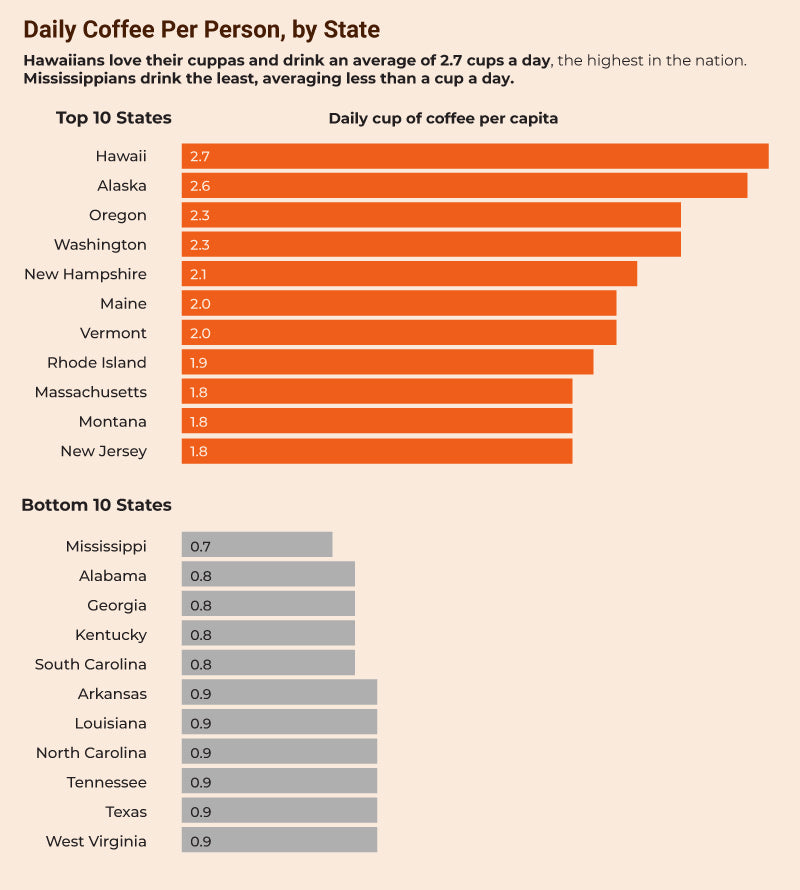
How Much is Coffee in the US?
Coffee prices change often and are on the rise! The average coffee price costs $3.77 in 2024 in the United States [25].
If you like to grab coffee in a cafe, the best spots are Colorado, Oregon, and California, which have the highest number of coffee shops per capita [64].
3. Who are the Number 1 Coffee Drinkers in the US?
The number 1 coffee drinkers in the US are people between 30 and 44 years as well as people over 65. As for gender, an equal percentage of men and women drink coffee. Lastly, there are more Whites and Hispanics who drink coffee than Black Americans.
Which Age Group Consumes the Most Coffee?
People between 30 and 44 years as well as people over 65 consume the most coffee. More than 3 out of 4 (77%) people in their age groups drink coffee [20].
Younger adults aged 18 to 29 years drink the least amount of coffee, with just over two-thirds (68%) of them drinking coffee.

Based on Frequency, Which Age Group Drinks the Most Coffee?
People aged 65 and older drink the most coffee, with 56% of them drinking one to more than five times a day. Only 43% of people from the youngest age group (18 to 29 years) drink the same [20].
However, people aged 30 to 44 years often exceed the daily caffeine limit of 400 mg (approximately four cups). Around 11% of them drink five or more times a day, compared to people 65 and older (6%) and adults aged 18 to 29 and 45 to 64 (5% each).
On average, how many cups of coffee per day do Americans drink?
Around 38% of Americans drink coffee one to two times per day. About 7% exceed the daily limit and drink coffee five or more times per day.

Which Age Group Consumes the Most Caffeine?
People above 40 years of age consume the most caffeine (any source) at around 264.8 mg per day. On the other hand, young adults consume the least at only around 203.6 mg per day [34].

Coffee is their primary source of caffeine, making up 69% of all sources. Energy drinks land second with 17%, while tea (8%) and soda (6%) follow in third and fourth places. Less than 1% get their caffeine fix from caffeinated gums or medications.
What is the Daily Caffeine Intake Per Age?
How many coffees a day can we drink? The FDA recommends that adults consume no more than 400 mg of caffeine per day. This is around two to three cups (12 fl oz) of coffee every day [65].
The US has no specific caffeine intake recommendations for minors, but the American Academy of Pediatrics discourages them from consuming caffeinated foods and beverages.

Canada, however, has a basic caffeine intake guideline for children and recommends [32]:
- 85 mg to 100 mg per day for adolescents
- No more than 85 mg per day for children aged 10 to 12
- No more than 62.5 mg for children aged 7 to 9
- No more than 45 mg for children aged 4 to 6
Children younger than 4 years of age should have no caffeine [68].
What are the Gender Statistics for Coffee?
An equal percentage of (75%) men and women drink coffee regularly. However, there are more women (25%) than men (24%) who don’t drink coffee.

What Gender Consumes the Most Caffeine?
On average, we consume around 243.1 mg of caffeine (any source) a day. However, men tend to consume 1.3 times more caffeine (any source) than women at 250.7 mg and 194.5 mg, respectively [34].
More women (39%) drink coffee once or twice a day than men (35%). However, men (9%) tend to overconsume coffee than women (4%), drinking five or more cups per day [20].

What Ethnic Group Drinks the Most Coffee?
White Americans drink the most coffee, with 76% of their population drinking coffee. Hispanics follow in second place with 73%.
Blacks, on the other hand, have the lowest percentage of coffee drinkers. Only 65% of their population drink coffee [20].

What Ethnic Group Consumes the Most Caffeine?
Whites also consume the most caffeine (any source) per day, at 263.5 mg of caffeine. Hispanics follow at 227.7 mg, while Blacks consume the least amount of caffeine at only around 158.8 mg [34].
What Profession Drinks the Most Coffee?
According to a 2014 survey by Pressat, journalists and media staff drink the most coffee, followed by police officers and teachers. Plumbers and trade workers ranked fourth, while nurses and medical staff ranked fifth [47].
Other heavy coffee drinkers are company executives, telesales, IT technical support, retail staff, and drivers.

Around 85% of the 10,000 professionals say they drink at least three cuppas a day, and 70% of them say going without coffee will affect their work performance.
What is the Most Popular Drink in the World?
Wondering what is the most consumed beverage in the world? Well, water is the most consumed drink in the world. But barring water, coffee is also one of the most consumed beverages in the world. It has a global search volume of 16.4 million, 13.7 times more than the global search volumes of tea and wine with 1.2 million each [49].
We used Google Trends to track the popularity of these top five drinks in real time. Over the past year, water consistently had the highest “interest over time,” with an average of 87. Coffee ranked 2nd with 36, while tea ranked third with 23.

What is the Most Popular Type of Coffee Beans?
When it comes to the type of coffee beans, arabica is way more popular than robusta. About 70% to 80% of coffee drinkers prefer arabica to robusta [43].
What are the Most Popular Types of Coffee in the US?
Regular coffee remains the most popular coffee in the US, with 88% of coffee drinkers enjoying it. Cappuccino is the second most popular type of coffee at 71%, while iced coffee and mocha land third place with 65% each [20].
America’s least favorite coffee is cold brew. Only 47% of coffee drinkers say they enjoy the drink, while 31% say they don’t enjoy it at all.

The top 10 coffee types in the US include:
- Regular coffee
- Cappuccino
- Iced
- Latte
- Mocha
- Frappuccino
- Espresso
- Macchiato
- Americano
- Cold Brew
What Percent of Coffee Drinkers Drink Black?
Around 1 in 5 (20%) coffee drinkers in the US prefer their coffee black with no milk or creamer. The majority (79%) like their coffee with some level of creamer or milk [20].
Another survey found almost similar results, shedding light on how some people like their coffee. Only 17.6% prefer black coffee, while 6% like black coffee with sweeteners. Most coffee drinkers (38.9%) like their coffee with milk or creamer only, while 37.5% like it with sugar and milk or creamer [55].

What is the Most Loved Coffee in the World?
Coffee drinkers are flocking to espresso-based beverages, with consumption of cappuccinos, lattes, and flat whites up by a staggering 50% since 2015 [42]. The strong popularity these beverages have with 25-39-year-olds is likely the largest contributing factor to its growth.
Whether they will continue to appreciate more of the subtleties and potential that coffee has to offer as they reach higher ages has yet to be seen. Still, as the trend continues, producers are likely to increase the quality and value of their offerings to account for this shift (or risk losing out on the market share).
During the pandemic, a lot of people had the chance to acquaint themselves with different ways to make delicious coffee in their own homes. They may come to expect more out of a coffee shop as the quality of coffee at home continues to rise.
What are the Most Popular Coffee Flavors?
Nearly 3 in 5 (58%) coffee drinkers say they prefer adding flavors to their coffee. Of the different coffee flavors, vanilla is the preferred flavor by 38% of coffee drinkers [37].
The second most popular coffee flavor is hazelnut and is preferred by 27% of coffee drinkers. Caramel follows with 22%, mocha with 19%, and French vanilla with 15%.

What is the Most Common Coffee Brewing Method?
Drip coffee makers remain the most common coffee brewing method preferred by 49% of coffee drinkers in the US. Single-serve pod machines ranked second with 33%, while instant coffees landed the third spot with 17% [20].
The least common coffee brewing method is coffee bags, with only 5% using it.

Is Filtered Coffee Healthier?
Filtered coffee (drip coffee and Vietnamese coffee using a Phin filter) is generally considered healthier than unfiltered coffees like Turkish coffee or French Press coffee. The paper or steel filter can trap diterpenes like kahweol and cafestol, compounds linked to higher cholesterol levels.
Drinking filtered coffee has been associated with a 15% lower risk of dying from any cause compared to non-coffee drinkers [35].
It has also been linked to a 12% lower risk of dying from a cardiovascular event in men. Women who drink filtered coffee also have a 20% lower risk of dying from heart disease than non-coffee drinkers.

Is Coffee Good or Bad for You?
Moderate coffee consumption is generally good for you, and people who drink coffee tend to live longer than non-coffee drinkers. According to a study, drinking 2.5 to 4.5 cups of coffee can lower your risk of dying by as much as 29% [38].

What is a Health Fact About Coffee?
Science has proven that coffee has health benefits, and more than one-third (36%) of coffee drinkers in the US also believe this health fact [20].
What are the Effects of Coffee on the Body?
There are several positive health effects associated with coffee consumption:
- Expresso (14.2 mmol/100 g) contains the most antioxidants compared to other beverages like red wine (2.5 mmol/100 g) and green tea (1.5 mmol/100 g) [11]. Antioxidants neutralize free radicals, which damage the cells.
- Three to five cups of coffee a day can help lower your risk of developing cardiovascular disease by 15% [60].
- Three to four cups of coffee a day can also help lower your stroke risk by 21% [63].
- Increasing your coffee consumption by more than a cup in a four-year period lowers your type 2 diabetes risk by 11% [6].
- Regular coffee consumption lowers cancer occurrence risk by about 13% and appears to be protective against various cancers [75].
- Drinking at least three to five cups of coffee a day reduces dementia and Alzheimer’s disease risk by 62% to 70%, compared to non-coffee drinkers [59].
What Does Drinking Coffee Every Morning Do to Your Gut?
An 8-oz cup of coffee contains around 480 mg of polyphenols and 1.45 g of fiber [21,24,65]. Polyphenols are natural compounds found in plants and are very beneficial to gut health. They encourage the growth of helpful gut bacteria and, at the same time, limit the bad ones.
Coffee is also a natural laxative and increases colonic monitor activity by around 50% [31]. Together with its fiber content, coffee can help prevent constipation and maintain a healthy gut.
Are There Specific Coffee Benefits for Men?
Nearly 1 in 5 (18.4%) American males over the age of 20 have erectile dysfunction (ED). According to a study, men who consume around 85 mg to 170 mg of caffeine a day (around 1 to 1.5 cups of coffee) are 42% less likely to report symptoms of ED than those who consume no more than 7 mg of caffeine a day [73].
On the other hand, men who drink 171 mg to 303 mg of caffeine a day (1.5 to 3 cups of coffee) are 39% less likely to report the same compared to their counterparts.

Another study found that men who drink 2 to 3 cups of coffee a day (around 170 mg to 375 mg of caffeine) have a lower likelihood of having ED [40].
What are the Black Coffee Benefits for Male and Female Health?
The healthiest coffee is plain, black coffee. It has zero additives, calories, sugar, carbohydrates, fat, and sodium [29].
In addition to the coffee health benefits mentioned earlier, people who drink black coffee also get to enjoy these unique benefits not found in other coffee types.
- Drinking black coffee won’t break your fast, making it a good choice for those on a diet.
- It’s dairy-free and easier on the stomach, making it perfect for those with lactose intolerance.
What's Unhealthy About Coffee?
Coffee may have health benefits, but overconsumption can also negatively impact our health. When asked about the effects of moderate coffee consumption, more than 1 in 10 (11%) people say it can be harmful to one’s health [20].
What are the Neg Effects of Coffee?
More than 1 in 3 (36.3%) coffee drinkers reported experiencing side effects from coffee. Around 17% reported feeling jittery and shaky, while 16.5% said they had trouble sleeping. Headache (11.5%) and rapid heartbeat (10.5%) are also very common [27].
The least common negative side effects are dental pain (0.8%), decreased sexual performance (0.3%), and seizures (0.2%).

Is Coffee Good or Bad for Aging?
Coffee is generally good for aging. One study actually showed that coffee can help slow down the biological aging process. It found that coffee drinkers have longer telomeres (one of the biomarkers for aging) than non-coffee drinkers [72].
- On average, each cup of coffee you drink is associated with an increase in telomere length by 33.8 base pairs. This slows down cellular aging by 2.2 years.
- If you’re a regular coffee drinker, each cup of coffee you drink per day lengthens telomeres by 40.3 base pairs and slows down cellular aging by 2.6 years.
Telomeres are found at the ends of the chromosomes and serve as the DNA’s protective caps. They prevent the ends from fraying or getting tangled. However, telomeres lose some of their length during cellular division and as cells age. Cell death occurs when the telomeres become too short, preventing cellular division. Simply put, the longer the telomeres, the more healthy years we get to enjoy.
Of note, the study found that caffeine consumption has the opposite effect and actually causes the telomeres to shorten.
Now, this may be confusing, especially since caffeine and coffee are oftentimes used interchangeably. However, caffeine and coffee are two different things and are not the same. Caffeine is just one compound found in coffee, while coffee includes other compounds like phenols, some of which may be beneficial to telomere length.
How Old Do You Have to Be to Drink Coffee?
Most Americans (36%) started drinking coffee regularly around the age of 21 or older. Around 28% started when they were between 17 and 20 years old. But when asked, more than one-third (35%) believe the ideal age for drinking coffee should be 17 to 20 years, while only 10% say to wait until 21 years or older [20].
A small percentage (14%) of coffee drinkers first drank coffee at the age of 12 or younger, and 13% of Americans are okay with children drinking coffee.

However, according to the American Academy of Pediatrics, children below the age of 12 should not consume caffeinated foods and beverages. Adolescents aged 12 to 18 should limit their intake to no more than 100 mg of caffeine per day [61].
Can a 70 Year Old Drink Coffee?
Yes, a 70-year-old can still drink coffee and experience no adverse effects. In fact, most elderly people can tolerate moderate amounts of coffee (about 50 mg to 100 mg of caffeine) without any issues [77].
How much coffee per day is okay for the elderly?
More than 3 in 4 (77%) of people aged 65 and older enjoy their coffee. Most of them (39%) drink a cup or two per day, and 11% are okay with three to four cups. However, a few (6%) just need to have more and drink five or more cups daily.

More than 4 in 5 (82%) like their coffees caffeinated, while 10% enjoy decaf. Most (27%) like it black, and the rest want their coffee with milk or creamer. About 37% enjoy cuppas with no sweeteners, while 47% like it with sugar and sugar alternatives [20].
Elderly people (65 to 85 years) can still enjoy an average cup of coffee. However, it will take them 33% longer to metabolize caffeine compared to people aged 20 to 40 years [7].
What are the Pros and Cons of Coffee?
Below are some of the pros and cons of caffeine (any source — coffee, tea, or energy drink):
- Toxicity: Consuming 200 mg of caffeine in one sitting is generally safe. But consuming more than 300 mg in one sitting can result in caffeine intoxication. The caffeine toxicity threshold in healthy adults aged 19 and older is 400 mg per day, adolescents aged 12 to 18 is 100 mg per day, and children aged 12 and younger is 2.5 mg per kg per day [59].
- Brain: At a lower dose (250 mg), caffeine produces more positive than negative effects. It can make you feel happy, elated, calm, and generally good. But at higher doses (500 mg), you’ll feel more of its side effects. You feel more irritable, nervous, anxious, nauseous, and restless [59].
- Heart: Three to five cups of coffee a day lowers your risk of cardiovascular disease by 15%. But if you’re hypertensive, coffee overconsumption can actually double your risk of cardiovascular disease-related death [60].
- Diabetes: People who increase their coffee consumption by even just one cup over a period of four years lower their type 2 diabetes risk by 11%. But decreasing coffee consumption by the same amount actually causes type 2 diabetes risk to jump by 17% [6].
- Tolerance and Caffeine Withdrawal: Caffeine has addictive properties. The more coffee you consume on a regular basis, the more you become desensitized to its effects. In the end, you’ll need to consume a higher dose just to feel the same effects. While 59% of coffee drinkers say they don’t develop caffeine withdrawal symptoms when abstaining from coffee, around 31% admit to experiencing them [20].
What I Noticed When I Stopped Drinking Coffee?
Nearly one-third (31%) of coffee drinkers experience side effects when they don’t drink coffee, with 75% reporting headache as the most common symptom. Around 42% also say they feel irritable, and 27% experience fatigue [20].
Stopping coffee can also mess up your concentration or make you feel nauseous and lightheaded.

Why Do People Drink Coffee?
Why are people drinking coffee anyway? More than 4 in 5 (83.1%) Americans drink coffee simply because they like how it tastes. Around two-thirds of coffee drinkers say coffee energizes them, while more than 2 in 5 say coffee increases their productivity [58].

What is the New Coffee Trend?
New coffee trends show we now care more for specialty and gourmet coffee beans and drinks than mass-produced coffee. Sustainability has also become a priority, with consumers favoring brands that engage in eco-friendly practices. Drip coffee makers will always be popular, but we’re also enjoying other brewing methods.
These are just some of the current coffee trends we’re seeing now.
Coffee Trends Show The Public is Excited About Specialty Drinks & Flavorings:
In the 2023 trends report from the National Coffee Association (NCA), 61% of Americans consumed traditional coffee in the last week, and 52% ordered a specialty drink [42]. Lattes, espressos, and cappuccinos were the most popular specialty coffees, tied at 16% of consumers, with 85% choosing hot over iced.

Medium sizes were most popular at 52%, with just 12% of Americans opting for a large, and 32% of consumers added a flavoring to their coffee. The most popular choices for added syrups were:
- Vanilla
- Mocha
- Caramel/butterscotch and hazelnut (tied)
- Irish cream and pumpkin spice (tied)
- Almond and maple pecan (tied)
Some of these flavorings — like pumpkin spice and maple pecan — tend to focus more on seasonal offerings. It’s hard to beat vanilla or mocha’s timeless relevance, however, and businesses would be smart to invest more in higher-quality offerings for these flavors.
Consumption Trends Show Gourmet Coffee Markets Are On The Rise
In 2020, 49% of Americans drank gourmet coffee beverages, outranking all other choices by at least 12% — and traditional coffee by 31% [50]. People have come to expect more from their cups as the prices have continued to rise.

With the availability of the French Press, Chemex, pour-over, and other at-home brewing techniques, it’s so easy to make a delicious cup of coffee at home. This means that if people are venturing out to spend money at a coffee shop specializing in the beverage, they’re anticipating it to taste better than what they can make at home.
Coffee shops have been stepping up their game for years to compete with the major players and ride the new coffee trend, but even Starbucks has begun offering pour-overs, cold brews, and other gourmet brews.
Consumer Interest In Sustainability For Coffee Brands Soars
CO2 equivalents are measured in the number of kilograms of CO2 that are released into the air per 1 kg of food.
Coffee’s impact on the environment is rather substantial, and a large amount of it is wasted coffee. In 2018, “losses” resulted in 11.47 kg of carbon dioxide being released into the atmosphere — the largest percentage of the 29 kg in total ascribed to the industry [23].
This puts coffee just above shrimp farming (27kg) and below dairy farming (33kg) and breaks down to:

As food waste continues to be an increasing problem, some countries are stepping up to try and address it.
The UK. Is Leading The Way on Sustainability in Coffee:
The same year as the data above was collected, the British Coffee Association (BCA) set out to change how it handled coffee’s ecological footprint. In the “Bean To Bin and Beyond” whitepaper, they outline several initiatives already underway and in the planning stages to lead to zero-waste packaging by 2025 [9].
But packaging is just part of the story; the biggest problem is losses, which the BCA suggests represents a "circular" opportunity. In the future, it may be possible to collect wasted coffee grounds and recycle them into biofuel to power cities.
In doing so, old coffee could fuel the production of new coffee (and perhaps beyond” to create an economy devoid of waste.
Unfortunately, this is still mostly theoretical, and we're likely a long way from being able to implement anything as revolutionary as this. Still, the UK is positioning itself to be the forerunner in innovations in this arena.
Current Coffee Trends Show We’re Getting More Creative with Brewing Styles
Never before have unique preparation methods been so popular, and Americans love to prepare their coffee in many ways. Most still prefer auto drip coffee makers, single-cup brewers, and espresso machines. But we’re not hesitant to try less popular methods like cold brew, French press, Moka pot, pour over, and percolator.
Coffee consumption has been on the rise for years, and as households around the world access more income and the population ages, coffee consumption will continue to rise.
The way coffee is consumed is also changing, with fewer people drinking black coffee and alternative milks like oat and almond becoming a growing trend.
Underneath It All: Everyone Is Drinking More Coffee
COVID-19 left an undeniable mark on coffee shops, but things seem to be rebounding — and at-home coffee sales have maintained a high level. In the NCA’s 2023 trends report, 91% of people who drank coffee in the last week paid for it at least once [42].
37% of the same population bought their coffee at least four times per week. With most Americans (69%) still using a traditional drip or single-cup coffee maker, it makes sense that they’d step out for something with a little extra care.
Just because it doesn't contribute as highly to the net revenue of the coffee industry doesn't mean the drip coffee maker isn't important, however. Every day, Americans are finding their energy in the warm, dark embrace of coffee — that's something that isn't going away any time soon.
FAQ: Quick Coffee Facts and Fun Coffee Statistics
Can’t get enough of coffee? Listed below are some quick coffee statistics and fun facts to make your coffee knowledge richer.
1. What are the Statistics of Coffee in the US?
75% of Americans drink coffee, with an equal percentage of men (75%) and women (75%) enjoying their daily cuppas [20].
Caffeinated beverages aren’t our only caffeine source. We also enjoy getting our caffeine fix from coffee-based desserts, the most popular of which is coffee cake (61.6%). Coffee ice cream followed with 54%, while Irish coffee ranked 3rd with 35.1% [57].
2. What are Four Facts About Coffee Market in the US?
Here are four facts about the US coffee market [53–54]:
- The country’s coffee market generated $86.08 billion in revenue in 2023, with the roasted coffee market ($74.08 billion) generating 6.2 times more revenue than the instant coffee market ($12 billion).
- The coffee market revenue is forecasted to increase by 2.87% in 2024 to $88.55 billion.
- We spend more on roasted coffee, with each person spending around $217.87 in 2023. This is expected to grow by 1.11% in 2024 to $220.29.
- We spend less on instant coffee, spending only around $35.29 per person in 2023. This is forecasted to increase by 9.83% in 2024 to $38.76.
3. What is a Fun Fact About Coffee History?
Coffee didn’t start out as a social beverage. Its initial uses were for mystic rituals by the Sufis in the late 1400s and as a medicine by the Ottoman Empire [13].
4. What are 7 Facts About Coffee You Didn't Know?
Here are 7 interesting facts about coffee that you may not know [18–19,28,46,70–71]:
- Coffee is not a bean but a fruit. We only call them “bean” because the fruit resembles a true bean.
- The most commonly produced coffee beans are arabica and robusta, and we produce 1.2 times more arabica than robusta.
- Coffee was once called the Infidel’s Drink during the early 1600s and was nearly banned in Europe.
- Coffee is the only beverage that received a Pope’s blessing. Coffee was almost declared “evil” until Pope Clement VIII tried it. He liked it and gave it his papal blessing.
- We used to drink unfiltered coffee and only began drinking filtered coffee using cloth in 1683. But the coffee filter we’re more familiar with was only invented in 1908.
- Decaffeinated coffee was invented in 1906.
- Instant coffee was invented in 1938.
4. What are the Statistics for Caffeine Intake?
Most Americans (79%) enjoy caffeinated coffee, while only 10% like decaf [20]. Caffeine gives our energy an extra kick, but we should limit our intake to no more than 400 mg of caffeine a day [65]. Overconsumption can lead to some uncomfortable side effects.
5. What are 5 Facts About Caffeine in Coffee Beans?
Here are 5 facts about caffeine in coffee beans that you may not know [3–5,76]:
- Robusta beans contain double the caffeine content of arabica beans. One robusta bean has 2.09% caffeine content, compared to one arabica bean’s 1.09%.
- An 8-oz cup of arabica coffee contains around 109 mg of caffeine.
- An 8-oz cup of robusta coffee, on the other hand, has double the caffeine content at around 209 mg of caffeine.
- Regular coffee contains 3.2 times more caffeine than green tea. It also has 2 times more caffeine than black tea.
- Vietnamese robusta coffee is more potent than regular robusta beans. One bean of Cafely’s BanMe has 2.7% caffeine. Regular robusta beans, on the other hand, have only around 2.2% to 2.4% caffeine content.
6. What are 5 Interesting Facts About Caffeine?
Here are 5 interesting facts about caffeine that you may not be familiar with [20,44,66]:
- Caffeine has a half-life of four hours and can take up to 12 hours for your body to fully eliminate.
- Consuming more than 5 grams of pure caffeine can be fatal, resulting in toxicity or, worse, death. This is equivalent to drinking 30 to 50 cups of coffee in one sitting.
- Caffeine is pretty addictive, and 31% of those who try to quit coffee develop withdrawal symptoms.
- Caffeine withdrawal typically starts 12 to 24 hours after the last caffeine intake.
- The brewing method that extracts the most caffeine is espresso (126 mg of caffeine per 30 mL), while pour over extracts the least (20.8 mg of caffeine per 30 mL).
8. When Did Coffee Become Popular?
The Ottoman Empire tried to maintain its monopoly on coffee, but when coffee reached Europe in the early 1500s, there was no stopping its rapid spread [41]. Its popularity soon grew across the continent. By 1616, coffee had reached Asia, and in 1723, it reached Martinique before spreading to Latin America [18].
9. What is a Fun Fact About Coffee Drinkers?
In 1781, Prussia’s King, Frederick the Great, banned coffee and encouraged his people to drink beer instead. France also banned coffee several years later in 1806, and the country’s coffee drinkers had to turn to chicory coffee as an alternative [18].
Of note, roasted chicory root makes a good coffee for people who don't like coffee.
10. Was Einstein a Coffee Drinker?
Einstein was a coffee drinker, but he preferred caffeine-free coffee made by Kaffee Haag [12]. Its founder, Ludwig Roselius, discovered how to remove caffeine from coffee beans in 1906 [18].
References
- 10 Largest food chains in Canada in 2024. (2024). ScrapeHero.
- Allen, L. (2024). 2024 Coffee Statistics: Consumption, Preferences, & Spending. Drive Research.
- Beverages, coffee, brewed, prepared with tap water. (2019). U. S. Department of Agriculture.
- Beverages, tea, black, brewed, prepared with tap water. (2019). U. S. Department of Agriculture.
- Beverages, tea, green, brewed, regular. (2019). U. S. Department of Agriculture.
- Bhupathiraju, S. N., Pan, A., Manson, J. E., Willett, W. C., Van Dam, R. M., & Hu, F. B. (2014). Changes in coffee intake and subsequent risk of type 2 diabetes: three large cohorts of US men and women. Diabetologia, 57(7), 1346–1354.
- Briggs, I., Chidley, J. B., Chidley, C., & Osler, C. J. (2021). Effects of Caffeine Ingestion on Human Standing Balance: A Systematic Review of Placebo-Controlled Trials. Nutrients, 13(10), 3527.
- Brown, T. (2021). Coffee Consumption. British Coffee Association.
- Brown, T. (2023). BCA’s Bean to Bin and Beyond – Circular Economy Review Published. British Coffee Association.
- Buchholz, K. (2023). How Many Cups of Coffee Do Americans Drink Each Day? Statista.
- Carlsen, M. H., Halvorsen, B. L., Holte, K., Bøhn, S. K., Dragland, S., Sampson, L., Willey, C., Senoo, H., Umezono, Y., Sanada, C., Barikmo, I., Berhe, N., Willett, W. C., Phillips, K. M., Jacobs, D. R., Jr, & Blomhoff, R. (2010). The total antioxidant content of more than 3100 foods, beverages, spices, herbs and supplements used worldwide. Nutrition Journal, 9(3).
- Chilton, M. (2016). Albert Einstein: he really was an egghead. The Telegraph.
- Coffee, 1400-1800. (2021). University of California (UC Santa Cruz).
- Coffee bean production, 2022. (2024). Our World in Data.
- Coffee bean yields, 2022. (2024). Our World in Data.
- Coffee Consumption by Country 2024. (2021). World Population Review.
- Coffee Facts. (2024). Coffee Association of Canada.
- Coffee Timeline. (2020). Vanderbilt University.
- Coffee: World Markets and Trade: Global Market Analysis. (2023). In U. S. Department of Agriculture.
- Daily Survey: Coffee. (2022). YouGov.
- Díaz-Rubio, M. E., & Saura-Calixto, F. (2007). Dietary Fiber in Brewed Coffee. Journal of Agricultural and Food Chemistry, 55(5), 1999–2003.
- Dodd, A. (2021). The Most Coffee-Obsessed US States. SimpleTexting.
- Food: greenhouse gas emissions across the supply chain. (2018). Our World in Data.
- Fukushima, Y., Ohie, T., Yonekawa, Y., Yonemoto, K., Aizawa, H., Mori, Y., Watanabe, M., Takeuchi, M., Hasegawa, M., Taguchi, C., & Kondo, K. (2009). Coffee and Green Tea As a Large Source of Antioxidant Polyphenols in the Japanese Population. Journal of Agricultural and Food Chemistry, 57(4), 1253–1259.
- Global Coffee Prices and Trends 2024. (2024). Mandoe Media.
- Gunter, M. J., Murphy, N., Cross, A. J., Dossus, L., Dartois, L., Fagherazzi, G., Kaaks, R., Kühn, T., Boeing, H., Aleksandrova, K., Tjønneland, A., Olsen, A., Overvad, K., Larsen, S. C., Cornejo, M. L. R., Agudo, A., Pérez, M. J. S., Altzibar, J. M., Navarro, C., . . . Riboli, E. (2017). Coffee Drinking and Mortality in 10 European Countries. Annals of Internal Medicine, 167(4), 236–247.
- Hammond, D., Reid, J. L., & Zukowski, S. (2018). Adverse effects of caffeinated energy drinks among youth and young adults in Canada: a Web-based survey. CMAJ Open, 6(1), E19–E25.
- Here’s to Pope Clement VIII. (2020). Roman Catholic Diocese of Harrisburg.
- [Historical Record]: Black Coffee. (2019). U. S. Department of Agriculture.
- Immad, L. (2023). Top 20 Countries With The Highest Coffee Consumption. Yahoo Finance.
- Iriondo-DeHond, A., Uranga, J. A., Del Castillo, M. D., & Abalo, R. (2020). Effects of Coffee and Its Components on the Gastrointestinal Tract and the Brain–Gut Axis. Nutrients, 13(1), 88.
- Is Coffee Bad for Kids? (2023). Johns Hopkins All Children’s Hospital.
- Japan Coffee Market: Industry Analysis and Forecast (2024-2030). (2022). In Stellar Market Research (SMR_69).
- Knapik, J. J., Steelman, R. A., Trone, D. W., Farina, E. K., & Lieberman, H. R. (2022). Prevalence of caffeine consumers, daily caffeine consumption, and factors associated with caffeine use among active duty United States military personnel. Nutrition Journal, 22.
- LaMotte, S. (2020). The healthiest way to brew your coffee. CNN.
- Lindner, J. (2024a). Starbucks Customers Statistics. Gitnux.
- Lindner, J. (2024b). Vanilla, Hazelnut, and Caramel Reign as Most Popular Coffee Flavors. Gitnux.
- Liu, D., Li, Z., Shen, D., Zhang, P., Song, W., Zhang, W., Huang, Q., Chen, P., Zhang, X., & Mao, C. (2022). Association of Sugar-Sweetened, Artificially Sweetened, and Unsweetened Coffee Consumption With All-Cause and Cause-Specific Mortality: A Large Prospective Cohort Study. Annals of Internal Medicine, 175(7), 909–917.
- Loftfield, E., Freedman, N. D., Dodd, K. W., Vogtmann, E., Xiao, Q., Sinha, R., & Graubard, B. I. (2016). Coffee Drinking Is Widespread in the United States, but Usual Intake Varies by Key Demographic and Lifestyle Factors. Journal of Nutrition, 146(9), 1762–1768.
- Lopez, D. S., Wang, R., Tsilidis, K. K., Zhu, H., Daniel, C. R., Sinha, A., & Canfield, S. (2015). Role of Caffeine Intake on Erectile Dysfunction in US Men: Results from NHANES 2001-2004. PLoS ONE, 10(4), e0123547.
- Myhrvold, N. (2021). History of coffee. Encyclopedia Britannica.
- National Coffee Data Trends Report. (2024). National Coffee Association of U.S.A.
- Nguyen, C. (2021). Is Arabica coffee better than Robusta coffee? K-Agriculture.
- Nierenberg, C. (2016). 10 Interesting Facts About Caffeine. Live Science.
- Ogunwole, S., Rabe, M., Roberts, A., & Caplan, Z. (2021). Population Under Age 18 Declined Last Decade. U.S. Census Bureau.
- Paajanen, S. (2019). The Evolution of the Coffee House. The Spruce Eats.
- Pressat Team. (2014). Here are the professions that glug the most coffee. Journalists are officially the biggest addicts. Pressat.
- Production, Supply and Distribution Online (PS&D). (2024). United States Department of Agriculture, Foreign Agricultural Service.
- Qureshi, T. (2024). 5 Most Consumed Beverages in the World. Insider Monkey.
- Ridder, M. (2022). Share of U.S. gourmet coffee beverage consumption by type 2020. Statista.
- Ridder, M. (2023). Coffee consumption in Canada 2010-2023. Statista.
- Ridder, M. (2024a). Coffee consumption frequency in the United Kingdom 2024. Statista.
- Ridder, M. (2024b). Coffee market revenue in the United States 2019-2029, by segment. Statista.
- Ridder, M. (2024c). Coffee market revenue per capita in United States 2019-2029, by segment. Statista.
- Ridder, M. (2024d). Favorite way of drinking coffee in the U.S. in 2023. Statista.
- Ridder, M. (2024e). Global coffee consumption 2012/13-2021/21. Statista.
- Ridder, M. (2024f). Preferred coffee-based drinks/dishes in the U.S. 2023. Statista.
- Ridder, M. (2024g). Reasons for drinking coffee in the U.S. in 2023. Statista.
- Rodak, K., Kokot, I., & Kratz, E. M. (2021). Caffeine as a Factor Influencing the Functioning of the Human Body—Friend or Foe? Nutrients, 13(9), 3088.
- Rodríguez-Artalejo, F., & López-García, E. (2018). Coffee Consumption and Cardiovascular Disease: A Condensed Review of Epidemiological Evidence and Mechanisms. Journal of Agricultural and Food Chemistry, 66(21), 5257–5263.
- Schneider, M. B., Benjamin, H. J., Bhatia, J. J., Abrams, S. A., De Ferranti, S. D., Silverstein, J., Stettler, N., Thomas, D. W., Daniels, S. R., Greer, F. R., McCambridge, T. M., Brenner, J., Cappetta, C. T., Demorest, R. A., Halstead, M. E., Koutures, C. G., LaBella, C. R., LaBotz, M., Loud, K. J., . . . Rice, S. G. (2011). Sports Drinks and Energy Drinks for Children and Adolescents: Are They Appropriate? PEDIATRICS, 127(6), 1182–1189.
- Shahbandeh, M. (2023). Coffee consumption in the U.S. 2013/14-2023/2024. Statista.
- Shao, C., Tang, H., Wang, X., & He, J. (2021). Coffee Consumption and Stroke Risk: Evidence from a Systematic Review and Meta-Analysis of more than 2.4 Million Men and Women. Journal of Stroke and Cerebrovascular Diseases, 30(1), 105452.
- Sherman, E. (2021). New Study Found the Most, and Least, Expensive States to Buy a Cup of Coffee In. Matador Network.
- Spilling the Beans: How Much Caffeine is Too Much? (2023). US Food and Drug Administration (FDA).
- Study reveals which cup of coffee delivers the biggest caffeine kick. (2018). The University of Newcastle, Australia.
- Suryawanshi, S. (2023). Coffee Market - Companies, Size, Share & Research Analysis. In Coherent Market Insights (No. CMI5615).
- Taylor, A. J. (2017). How Much Caffeine is Safe for You and Your Child. MedStar Health.
- The Economic Impact of the Coffee Industry. (2021). National Coffee Association of U.S.A.
- The fascinating history of NESCAFÉ. (2024). Nescafé.
- The History of Coffee. (2015). National Coffee Association of U.S.A.
- Tucker, L. A. (2017). Caffeine consumption and telomere length in men and women of the National Health and Nutrition Examination Survey (NHANES). Nutrition & Metabolism, 14(1), 10.
- University of Texas Health Science Center at Houston. (2015). Caffeine intake associated with reduced levels of erectile dysfunction. ScienceDaily.
- World Population by Country 2024 (Live). (2024). World Population Review.
- Yu, X., Bao, Z., Zou, J., & Dong, J. (2011). Coffee consumption and risk of cancers: a meta-analysis of cohort studies. British Medical Journal Cancer, 11, 96.
- Zainuri, N., Paramartha, D. N. A., Fatinah, A., Nofrida, R., Rahayu, N., Anggraini, I. M. D., & Utama, Q. D. (2023). The Chemical Characteristics of Arabica and Robusta Green Coffee Beans. BIOTROPIA, 30(3), 318–328.
- Zivković, R. (2000). Coffee and health in the elderly. Acta Medica Croatica, 54(1), 33–36.
